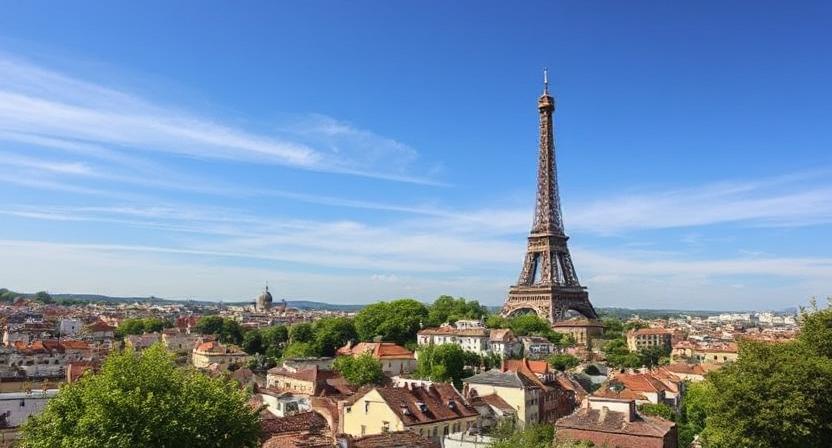Home
»
TOURISM NEWS
»
France ‘s Tourism Strategy: Sustainable Growth and Regional Diversification
Published on
August 11, 2025 |
Despite overcrowding and anti-tourism protests in certain regions of Europe, France is still one of the world’s most popular countries to visit, attracting millions of tourists annually. In 2024, France received a record 50 million tourists, and tourism is still a key contributor to the economy. While most neighboring nations such as Spain, Italy, and Portugal are experiencing protests and unrest over overcrowding, France is remarkable in its relative absence of tourist backlash, a phenomenon that has raised eyebrows among industry watchers.
The French state and tourism authorities have pursued an approach that meets increasing demand, yet places sustainability and the distribution of tourists at the forefront. France’s active strategy to diversify tourism away from conventional centers such as Paris has enabled it to escape some of the worst excesses of mass tourism.
Sustainable Tourism: France’s Long-Term Vision
Unlike many countries that have only recently started responding to the challenges of mass tourism, France began its efforts to implement sustainable tourism practices years ago. Atout France, the national tourism agency, laid the groundwork for these changes through initiatives like the Destination France Plan, launched with a €1.9 billion investment in 2021 to promote greener, more responsible travel.
This long-term commitment has allowed France to lead in sustainable tourism by focusing on rail travel over short-haul flights, supporting mid-sized cities as alternatives to overcrowded destinations, and encouraging visitors to explore regions beyond the typical tourist areas. According to Veronica Diquattro, President of B2C and Supply at Omio, France’s vast rail network—spanning 28,000 kilometers of tracks, including 2,800 kilometers of high-speed lines—has reshaped the tourism landscape by providing easy access to less-visited areas.
Rail Travel: A Sustainable Alternative
With its extensive rail network, France has become one of Europe’s most accessible countries for rail tourism. The availability of high-speed trains has allowed travelers to easily visit cities like Marseille and Strasbourg within a few hours from Paris, which was previously difficult to achieve in many parts of Europe. In 2023, France took a major step in promoting eco-friendly travel by formally banning domestic flights on routes that could be completed in under two and a half hours by train. This move has encouraged travelers to choose train travel instead of air travel, helping reduce carbon emissions and ease congestion in major cities.
Additionally, these efforts have helped promote regional tourism by encouraging visits to smaller cities and rural areas. With train accessibility and a focus on sustainability, more tourists are exploring places that would otherwise remain overlooked, contributing to more evenly distributed tourist traffic throughout the country.
Cultural and Natural Assets Spread Across Regions
France’s strategy to spread tourism across different regions rather than concentrating it in a few popular destinations is central to its success. As Marine Prat, a travel designer for Loire Secrets, noted, “Tourists are spread out in France. They don’t go to only one place; they travel to several regions.” This approach is in part due to France’s historical identity as a country of distinct regions, each offering unique experiences—from the châteaux of the Loire Valley to the wineries of Alsace. Social media, particularly Instagram, has fueled interest in off-the-beaten-path destinations, where travelers can explore charming villages, gastronomy, and dynamic cities within an hour of Paris.
Challenges and Solutions: Addressing Overtourism Concerns
While France’s tourism strategy has been largely successful, it hasn’t escaped the challenges posed by overtourism. Cities like Paris continue to grapple with crowding and gentrification issues. The Olympic Games in 2024 attracted over 50 million visitors to Paris, raising concerns about the city’s ability to manage such a high volume of tourists. Residents in areas like Montmartre have expressed frustration over the increasing commercialization of tourist hotspots, with tourists flocking to iconic locations like the Eiffel Tower and Notre-Dame without contributing to the local community.
To mitigate these challenges, France has implemented regulations like the Loi le Meur, a law passed last year that allows local governments to cap short-term rentals and limit the number of nights properties can be rented. These measures aim to reduce the housing crisis caused by the influx of tourists and maintain the quality of life for residents.
Future Outlook: Sustainable and Inclusive Tourism in France
France’s approach to sustainable tourism is gradually becoming a model for other countries to follow. With its focus on ecological tourism, digital inclusion, and cultural heritage, the country is ensuring that tourism remains a vital and responsible sector in the economy. The French government’s emphasis on regional inclusion and reducing seasonal overcrowding by promoting year-round travel is critical to keeping tourism in balance.
As global tourism patterns evolve, France’s tourism model—focused on spreading visitors across regions, investing in eco-friendly travel, and protecting local communities—is poised to remain a key player in the sustainable tourism landscape.
France’s Balanced Approach to Tourism Management
Amidst rising tourism overcrowding, France has been conscious enough to achieve the fine balance of preserving its cultural and natural attractions while avoiding that tourism development overpowers its infrastructure or population. Through its practice of long-term, sustainable practices such as encouraging rail travel, dispersing tourism throughout the country, and preserving local environments, France provides a model for managing the future of international tourism on a sustainable and inclusive basis. As the nation’s tourism infrastructure continues to develop, it will be well-placed to serve the needs of travelers who are looking for authentic, environmentally responsible, and culturally rewarding experiences.
